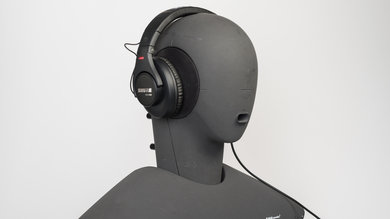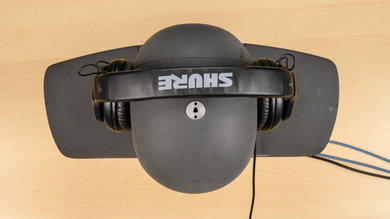Our Verdict
Mediocre for mixed usage. These headphones are best used for critical listening as they don't block enough noise for commuting, and they're a bit too bulky for sports. They leak a little at high volumes, so they won't be the ideal headphones for the office either. However, they deliver in the sound department and are a decent option for both casual and critical listeners.
- Good audio reproduction.
- Sturdy and durable build.
- Comfortable fit.
- Poor noise isolation.
- Slightly bulky design.
- Bass delivery varies significantly across users. Sensitive to glasses.
Good for neutral listening. The SHR 440 deliver a decently balanced sound that caters well to instruments and vocals. The Bass is punchy without being overwhelming, and instruments are not too distant or too forward on most tracks they reproduced. However, there is a pretty noticeable spike in the treble range that may make certain tracks and frequencies sound a bit too sharp. They also do not have the best Soundstage due to their closed back design.
Sub-par for commuting. Their passive isolation doesn't block much noise, they have no controls, and they're not the most portable headphones.
Poor for sports. They're a bit too bulky and unstable to use while doing sports. They're also not particularly breathable headphones, so your ears will get quite hot when exercising with these headphones on.
Mediocre for office use. They won't block the chatter of a busy office and leak a bit at higher volumes. However, they shouldn't be too distracting at average volume levels.
Changelog
- Updated Nov 21, 2019: Converted to Test Bench 1.3.1.
- Updated Nov 21, 2019: Converted to Test Bench 1.3.
- Updated Feb 16, 2018: Converted to Test Bench 1.2.
- Updated Aug 29, 2017: Review published.
Check Price
Popular Headphones Comparisons
See our recommendations for the best over-ear headphones, the best headphones for studio, the best headphones under $100.
The Audio-Technica ATH-M40x and the Shure SRH 400 are both closed-back, open-ear headphones with similar performances for critical listening. The Shure are more comfortable and have a slightly more even sound profile, but they lack a bit in the low-bass. The Audio-Technica, on the other hand, have an overemphasized bass, particularly in the high-bass range, which can make them sound muddier.
The Beyerdynamic DT 1770 PRO are better headphones than the Shure SRH440 thanks to better build quality and better and more consistent bass delivery. However, they are way more expensive, and the Shure are very comfortable headphones that offer great value for their price tag. They are all plastic, but if you’re looking for budget critical listening headphones, the Shure are a great pick for sound quality. On the other hand, the metallic frame of the Beyerdynamic feels more high-end, and they isolate a bit more noise than the Shure.
Test Results
The Shure SRH 440 look somewhat similar to the Audio-Technica ATH-M50x. They also have a studio design that's a little bland, but the utilitarian look will work for some. They have a thick headband that's well padded and dense oval ear cups that make the headphone look durable. They only come in one color scheme, however, an all-black matte finish that's understated and won't stand out but also feels professional.
The Shure 440 are comfortable over-ear headphones. They have large ear cups that fit well around most ears. The headband is not too tight and the whole build is mostly plastic so they're relatively lightweight on the head. The quality of the padding, however, could be improved.
The Shure SRH 440 are decently sturdy headphones despite their all-plastic design. The headband is flexible and won't break even under heavy strain. The ear cups are also dense enough to withstand a few drops without getting damaged. However, the build quality does feel a little cheap and the exposed audio cables from the headband to the ear cups could get damaged through regular wear and tear and cannot be replaced.
The SRH 440s are not sports headphones. They will easily slip off your ears if you're doing high-intensity activities like running or working out. On the upside, they're stable enough during casual use and the detachable cable will disconnect if it's hooked on something provided you haven't locked it into the ear cups.
Sub-par consistency performance. The Bass Range of these headphones is susceptible to inconsistencies across humans. We also noticed that certain types of glasses could break the seal on these headphones and cause a significant drop in Bass. We measured the maximum of 18dB of difference at 20Hz between our human measurements. However, their Treble consistency is decent.
Very good Bass Range performance. Low-frequency extension is at 50Hz, which is decent. Low-bass, responsible for thump and rumble, is lacking by about 4dB. But the SRH 400 has more low-bass than SRH 240A. Bass and high-bass are nearly flat and within 0.50dB of our target. Also, their bass delivery varies significantly across users, and is sensitive to the quality of fit, seal, and whether you wear glasses. The response here represents the average bass response and your experience may vary.
Excellent Mid Range performance. The response is virtually flat, but consistently over our target by about 2dB. This gives a slight emphasis to the Mid Range, over Bass and Treble.
Very good Treble Range performance. Low-treble and treble are virtually flat up to 7KHz. The bump centering around 10KHz makes the S and T sounds on these headphones slightly sibilant and sharp.
Sub-par Isolation performance. These headphones do not isolate any noise in the Bass Range. In the Mid Range they achieve about 8dB of reduction, which is sub-par. In the Treble Range, they are able to reduce the outside noise by 24dB, which is about average.
Average Leakage performance. The significant portion of the leakage is spread between 500Hz and 5KHz, which is a relatively broad range. However, the overall level of leakage is low.
No compatible app.
Wired headphones, negligible latency.














